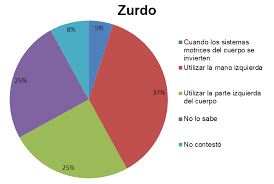

TEORIAS 2
19/02/2020
Theory
A particularity that is observed is that many times left-handed people excel in sports where only one member is used, such as tennis or fencing. This is due to the structure of their brains, whose corpus callosum (the fiber bridge that joins the two hemispheres) is more developed and allows a rapid mutual transmission of information from one hemisphere to the other. A great advantage in competitions where thousandths of a second are decisive. This cannot be observed in other depotrtes such as polo because the rules prohibit playing with the left hand.
Another issue to observe is that the left-handed brain has some differences with respect to the right-handed, such as that the temporal planum (a part of the brain located at the crossroads between the temporal, parietal and frontal lobes) is larger in the left hemisphere . This asymmetry could explain the preference for the manual.
When a child has not yet managed to define laterality (predominance of one part of the body over another) it is said to be ambidextrous (he develops the same ability with both hands). Most young children change hands or use both hands at the same time (this, for example, I notice in my daughter who has not yet turned three). It is around 4 years when the preference is established over one hand or another. Around 7 or 8 years is when it is known if the child is right-handed or left-handed, since that is when he opts for the hand of writing and "definitive lateralization" occurs (we speak of pure lateralization when the same side dominates in foot, hand and eye while talking about cross lateralization when, for example, it is right-handed and left-handed eye or vice versa). (María Jesús Raluy in the article "Left-handed or right-handed", in Other Theories and Research
There is a theory (which in some things is complemented by the most accepted) that indicates that the reason for this change in each other's brain, according to the English psychologist Marian Annett, is due to a gene that would determine the tendency to use the right hand, but there would be no other with the inverse effect (that is, according to this theory, left-handed people lack a gene or do not work properly. Mmmmmmmm)
According to some researchers, left-handedness would be due to "pathological processes experienced by the brain during pregnancy", for example in the case of brain traumas that affect the left hemisphere of the fetus or newborn, and that determine the passage of functions to the hemisphere not damaged. This hypothesis is not proven either.
Norman Geschweind noted that on the cortical surface of the brain there is a region that is generally wider in the left hemisphere than in the right, and that houses one of the areas related to the control of language activities. Then he showed that in most right-handed people there was this asymmetry, while a large part of the left-handed and ambidextrous brains were symmetrical "The genetic component is determining." Neurologist Exuperio Ten Tejedor, of the Spanish university hospital La Paz.
Another theory that states that high levels of testosterone (the male sex hormone) are responsible for the predominance of the left hand. But it is based solely on the fact that there are many more left-handed men than women
Only as of the 70s, researchers began treating the preference for the left hand not as a defect, but as a characteristic of the individual















